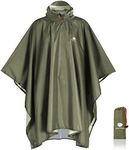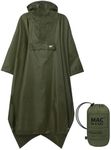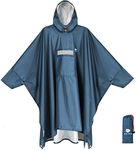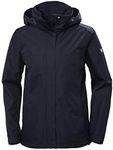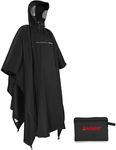Buying Guide for the Best Rain Ponchos
Choosing the right rain poncho can make a big difference in staying dry and comfortable during wet weather. When selecting a rain poncho, it's important to consider various factors such as material, size, weight, and additional features. Understanding these key specifications will help you make an informed decision and find the best fit for your needs.MaterialThe material of a rain poncho is crucial as it determines its waterproof capabilities and durability. Common materials include PVC, polyester, and nylon. PVC is highly waterproof but can be less breathable and heavier. Polyester and nylon are lighter and more breathable, often treated with waterproof coatings. If you need a poncho for heavy rain and durability, go for PVC. For lighter, more breathable options, choose polyester or nylon.
SizeSize is important to ensure the poncho covers you adequately and provides freedom of movement. Ponchos come in various sizes, from small to extra-large. A larger size offers more coverage and can accommodate a backpack underneath, which is ideal for hiking or commuting. If you need a poncho for everyday use or light activities, a standard size should suffice. For outdoor adventures, consider a larger size for better protection.
WeightThe weight of a rain poncho affects its portability and comfort. Lightweight ponchos are easier to carry and pack, making them ideal for travel and outdoor activities. Heavier ponchos may offer more durability and better protection in severe weather. If you need a poncho for occasional use or to keep in your bag for emergencies, a lightweight option is best. For frequent use in harsh conditions, a heavier poncho might be more suitable.
BreathabilityBreathability refers to how well the poncho allows moisture and heat to escape, preventing you from feeling clammy. Breathable ponchos are made from materials that allow air circulation while keeping rain out. This is particularly important if you plan to wear the poncho for extended periods or during physical activities. If you need a poncho for active use, prioritize breathability. For short-term or occasional use, this may be less critical.
Hood DesignThe hood design of a rain poncho can impact its effectiveness in keeping you dry. Look for ponchos with adjustable hoods that can be tightened around your face to prevent rain from getting in. Some hoods also have brims to keep rain off your face. If you expect to be in heavy rain or windy conditions, an adjustable hood with a brim is beneficial. For lighter rain, a standard hood may be sufficient.
Additional FeaturesAdditional features such as pockets, zippers, and reflective strips can enhance the functionality of a rain poncho. Pockets provide storage for small items, zippers can improve ventilation, and reflective strips increase visibility in low light. Consider what features are important based on your intended use. For example, if you need to carry items or be visible at night, look for ponchos with these features.





